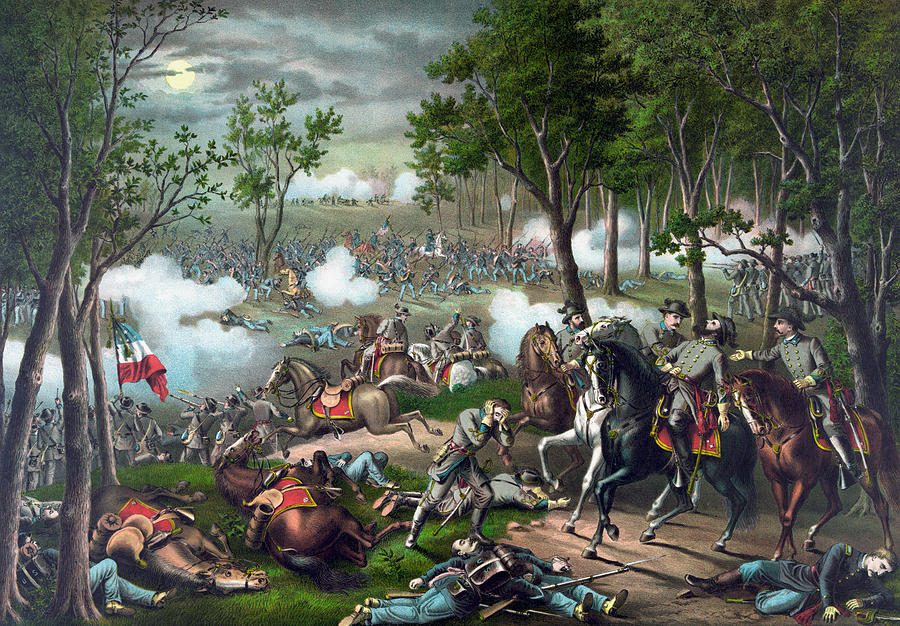Colquitt's Brigade at Chancellorsville
A Solo/Coop Play Scenario for In Freedom's Cause


"The right of your line does not appear strong enough."
General Hooker to General Howard, May 2, 1863, regarding his deployments at the far right end of the Army of the Potomac's position
The flank march of Jackson's corps at Chancellorsvile is one of the most famous incidents of the Civil War, and it represents an incredible feat of arms. Much of Jackson's leading division - Rodes' - was behind Howard's Union line, and the attack turned into a dash at the enemy's rear. But not every brigade in Rode's division was so positioned: Colquitt's Georgia brigade was at the rightmost end of Jackson's front line, opposite the hinge in Howard's position. Where many of Jackson's men were looking at an unopposed advance, Colquitt's men could not be sure what they would run into. Colquitt's right flank was not visibly supported.
Howard's position had been visited early that day by Hooker and his Chief engineer, Comstock, and both hints and advice had been given to Howard regarding what he should do in case of a flank attack. He does not seem to have payed them any heed - but he could have! He had an entire day to strengthen his position, had he wanted to.
It is quite plausible that Colquitt's brigade could have found themselves in a much different situation than they did, once the attack started, and that - if Howard had positioned his troops better, and dug them in - the results of Jackson's attack could have been less devastating.
This scenario is designed to explore this possibility: the Confederates may walk into an unprepared Union position, and find that their task is to see how fast they can clear the field. Or, it might go differently! In the worst case scenario, what should be an easy job could turn into a nightmare - a frontal assault against a large force of entrenched Union troops. Either of these extremes - or any situation in between - may occur.
The game app for In Freedom's Cause is used to determine what Colquitt and his men encounter. The victory conditions are thus highly variable: whatever situation unfolds, players will be judged on how well they handle it. If it is easy, they must push as hard as they can. If it is difficult, they must support Jackson's attack as best they can, pinning the Union forces to their front in place, and defeating them if they can.
Of any brigade under Jackson's command, Colquitt's was in the least-sure position. Historically, he advanced cautiously, holding up Ramseur's brigade behind him at a time when an all-out push forward was wanted. Despite Jackson's assurances, he was worried about his exposed flank to the south. In the event, he had no cause for concern, but his behavior on the day makes it clear that he was worried.
This scenario is designed to place players in Colquitt's shoes, and see how well they can handle the unexpected. Will an excess of caution again put a blemish on the "perfect battle"? Or will Colquitt show that he was right to be worried?
The map below shows the battlefield. It is generally open terrain - woods and hills will block line of sight, and woods will slow movement and provide soft cover. The hills will not impede movement unless covered by trees. The dashed black lines are split-rail fences, which will act as linear obstacles and provide soft cover to troops immediately behind them. The creek is fordable, but will count as rough for units moving through it.

Confederates may set up in any formation desired within the red dashed box, and must attack in the direction of the red arrow. The position and strength of the Union forces will become known as play proceeds. Jackson has assured you that there are no enemy forces to the south of you, and you are not expecting heavy opposition. Your orders are to advance with all speed.
Players will jointly command Colquitt's brigade, and he will be the only general on the table. Under his direct command will be the following units:
6th Georgia: 18 figures Veteran infantry armed with Minie Rifles
19th Gerogia: 12 figures Veteran infantry armed with Minie Rifles
23rd Georgia: 18 figures Veteran infantry armed with Minie Rifles
27th Gerogia: 18 figures Veteran infantry armed with Minie Rifles
28th Georgia: 12 figures Veteran infantry armed with Minie Rifles
Reese's "Jefferson Davis" Alabama Battery: 2 sections (4 guns) mixed 3-inch rifles and 12# Napoleons, 8 Veteran crew
The fighting on May 2nd went well into the night, with the attack starting at dinnertime (5 PM?) and lasting until after 9 PM when Jackson was made casualty by friendly fire, even as he was looking for a way to push the attack further. There is no fixed time limit on the game: if players clear the table, it will be a question of how quickly they were able to do it (10 turns would be fast). If enough Union troops show up, then clearing the table may not be an option, and it will be a question of whether their position can be taken. Typical game length would be 12-15 turns, although it could be obvious before then what the outcome will be.
Given the uncertain nature of the opposition forces, it is reasonable for players to discuss the extent of their victory (or defeat) with the GM at the end of play.